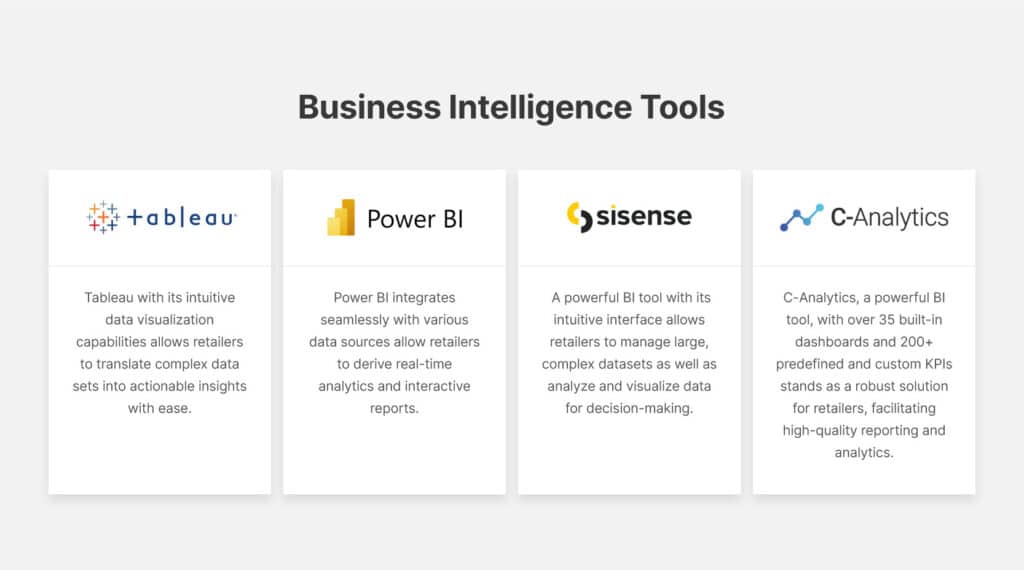There’s no denying that in the retail sphere, any retailer’s most important assets are its data and people. The sheer volume of data available to retailers serves as both a blessing and a challenge, demanding innovative approaches to extract meaningful insights.
Recognizing this prevailing concern, a significant transformation is unfolding as companies transition from traditional reporting methods in favor of modern data platforms. In fact, it wouldn’t be an overstatement to say that the most successful retailers are those who invest in AI and Big Data analytics. This strategic shift enables them to translate vast datasets into actionable insights, facilitating fact-based decisions for enhanced efficiency and a competitive edge.
The growing global AI retail market, projected to reach 31.18 billion U.S. dollars by 2028, stands as a testament to this evolution. This transition not only addresses the need for real-time, actionable insights but also signifies a strategic leap to keep pace with the competitors in an era where the convergence of data and AI is reshaping retail operations.
In this blog, we will explore the empowering impact and the use of AI in data analytics on retailer’s reporting and decision-making capabilities.
A closer look at the traditional reporting challenges in retail
In retail, every organization relies heavily on reporting to furnish both real-time and historical data, which is essential for monitoring company performance. Internally, various departments generate their own reports. This inundation of data – be it – structured, unstructured, or semi-structured – possesses several challenges that impede its ability to leverage data effectively.
To address these challenges, companies turn to reporting tools, leverage automation for data collection and report generation, and convert raw data into actionable insights. However, when digging into data in search of insights, some of the most common challenges that add a layer of complexity to carry out seamless analysis include:
- Poor data hygiene: Inconsistent or inaccurate data hampering the analysis process.
- Slow reporting processes: Delays in reporting impeding timely decision-making.
- Basic tabular and static reporting: Limited formats with short lifespans.
- Lack of visual dashboards: This is especially noticeable in executive reporting.
- Data aggregation hassles: Gathering data from multiple sources
- Inconsistency across reports: Discrepancies in data across different reports.
- Data security gaps: Concerns over the protection of sensitive information.
- Manual and lengthy reporting: Time-consuming processes, hindering efficiency.
- Lack of integrated reporting: Absence of a cohesive reporting framework.
- Insufficient actionable insights: Reports lacking practical, actionable information.
These challenges highlight the urgent need for a transformative approach to data management within the retail sector.
Now, what is the path forward for retailers?
Owing to the limitations of traditional reporting, retailers are now embracing business intelligence tools to propel themselves toward strategic decision-making. Consider notable solutions, such as Tableau, Power BI, Oracle, and C-Analytics – the big names. As retailers continue to generate massive volumes of data from various channels such as e-commerce, in-store purchases, social media, and mobile apps, having an effective retail data analytics solution becomes essential for driving growth and staying competitive.
These solutions are not just sorting the challenges posed by traditional reporting but are also allowing retailers to shape their operations proactively to expect maximum efficiency. Additionally, they are allowing companies to adopt swift reporting, stay up-to-date with the performance, and make decisions with data-driven insights.

McKinsey & Company states that retailers leveraging data analytics and operational reporting are 23 times more likely to attract new customers and up to 6 times more likely to retain their existing customer base.
This means that retailers who actively employ big data analytics platform and operational reporting tools have a significantly higher likelihood of gaining new customers and retaining existing ones – the ultimate goal of retailers.
Further reading: Future-proof your retail business by embracing data analytics & AI.
How AI in data analytics is a game-changer for retailers?
As retailers are on the path of modernization. AI implementation in data analytics has transformed the way they use and interpret data to gain deeper insights at their disposal. Data analytics in the retail industry offers meaningful and actionable insights to retailers for informed decision-making. From tracking customer preferences to predicting market trends, the value of leveraging big data cannot be overstated. With advanced data analytics retail platforms, businesses are going beyond traditional reporting to embrace real-time analytics and machine learning algorithms that provide deeper insights.
However, when it comes to reporting, the benefits of AI in data analytics for retail go beyond. What traditional reporting methods have the potential to achieve? These include:
- AI algorithms analyze historical data to identify patterns allowing retailers to use this capability to forecast future sales, demand, and trends with higher accuracy.
- AI automates the reporting process by streamlining data collection, analysis, and generation of reports, reducing the manual effort required for routine reporting.
- AI-powered retail data analytics provide real-time insights into customer preferences and market changes. And allow retailers to make informed decisions on the go.
Giant retailer, Walmart uses AI-driven data analytics to monitor sales performance and identify trends in customer behavior to enhance customer experience. Tesla uses AI for data analytics and is concurrently developing a versatile autonomous humanoid robot capable of performing an array of tasks. Similarly, streaming platform Netflix uses AI-powered analytics to track viewers’ watching habits and preferences, allowing it to recommend relevant content as soon as a user logs in.
Given AI’s significant impact on data analytics, IDC researchers predicted that by 2028, 50% of retailers will offer AI-enabled contextualized recommendations to enhance customer engagement, increasing real-time interactions by 30% and overall conversion rates by 20%.










